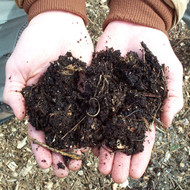Fast Composting vs Slow Composting
Easy compost making: throw some organic matter in a pile and wait.
But of course we never let it be that easy. For years, composters all over have been monkeying with the "how to compost" puzzle to come up with the perfect formula. Balancing ease of composting with speed has been the holy grail of composting.
Some years ago, hot composting came in vogue. This started the picture of the ideal compost pile: a mound of decomposing organic matter, steaming in the cool morning air. But if you take that picture forward, you will see the compost-master coming out with pitch fork to turn the pile. She'd check the temperature and moisture levels. She'd make sure her carbon to nitrogen levels were right. She'd have compost in weeks, but they were very busy weeks.
Hot composting takes a lot of work.
And so, over time, slow composting has gained status. Sure, the pile sits there a long time, but you're having a BBQ and drinking Margaritas while it does.
If you ask the composting aficionados, there are many, many different theories, styles and techniques to compost-making. But they boil down into 2 broad categories: hot (or fast) composting and cold (or slow) composting.
Compost Making the Hot Way:
- You need a good carbon/nitrogen ratio.
- You need good moisture (too wet and it won't get hot enough, too dry and it won't heat up either.)
- You need materials in small chunks (use a chipper?).
- Your carbon and nitrogen must be well mixed.
- Your pile must be built all at once. You can't add to this pile as you go along.
- You are less likely to attract animals and flies.
- You must turn every 3 days.
- Making hot compost kills most weed seeds and pathogens from the temperature.
- You can gloat to your neighbors that you are a master composter and have achieved the Composting Ideal.
Gather your materials in one area and make sure you have about 2/3 brown materials (carbon) to 1/3 green (nitrogen). Have the materials cut into smaller pieces--the smaller the better. Small pieces are obviously easier to compost and they have many nicks and cuts which allow the bacteria and fungi to get started.

Layer the brown and green material every few inches, adding water if necessary to have the dampness of a wrung out sponge. Add activator if desired.
Now comes the work.
Watch your pile heat up and 3 days later, turn it. 3 days later, turn again. Make sure your pile is 120° or more between turnings.
Turn the pile every few days for the next couple of weeks. When the pile ceases heating up at all, you are done.
This compost making process would be easier with a compost tumbler. Your pile would be smaller but you would not have as much pitch forking.
Compost Making the Slow Way:
- You need a "close enough" carbon/nitrogen ratio.
- Correct moisture will help but if you have the time, everything decomposes (unless it is completely dehydrated in a desert).
- Your materials can be in bigger chunks. The bigger, the more patience you need.
- You can add to it at your convenience.
- Your pile can take 1 (or more) years to fully decompose.
- The cool temperature allows disease-suppressing microbes to exist. You may end up with "healthier" compost.
- The cool temperatures may not kill all weed seeds and pathogens.
- You can turn it whenever you want--or not.
- In areas where you live near neighbors or appearances are important, having piles of compost sitting for long period of time may not be acceptable.
Gather your materials and have approximately the right balance of brown and green (link). Layer them while making sure the moisture level is good. When you have more, you can add more until your pile is about 1 cubic yard (1 cubic meter).
Go listen to music and have a glass of wine.
If you're feeling good and the weather is nice, turn your pile. If not, sit back down with a good book and relax.
Compost making the "cool" way is also the lazy way. If you have the room for your pile to sit, this is absolutely the way to go.
